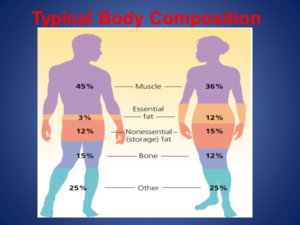The different components that the body is composed of are:
- Bones
- Organs
- Muscles
- Fat
Along with water, these are what our bodies are made up of. When we talk about your “fat free mass” we are talking about water, bones, organs and muscles. Once you have finished growing, your bones and organs don’t grow anymore – they continue to weigh about the same throughout adulthood. The two areas that you can change are muscle and fat.
There are two types of fat in your body composition:
- Essential fat: necessary for normal body function. This includes fatty tissue making up nerves, brain, heart, lungs, liver and mammary glands.
- Non-essential fat: this is simply fat or energy storage. This is also known as adipose tissue, and exists mainly just below the skin, and then around the organs. The fat around the organs is known as “visceral fat.” This varies from person to person.
The typical body composition of men and women is distributed as below:
Today, our lifestyles have led to a decrease in muscle mass and an increase in non-essential fat. The body has an unlimited capacity to store energy, leading to increasing amounts of excess fat. Men often carry their excess fat in the abdominal region, while women tend to carry it in the hips, thighs and buttocks.
Since two people can weigh the same, but be composed of completely different percentages of fat and muscle, a better way to determine the amount of excess fat a person has is by using a body composition analyzer. We now have a medical body composition analyzer in our Comprehensive Care Center. It works by measuring sound waves as they move through different types of body tissue. It can determine what percentage of fat and muscle is in your body. Sometimes a regular scale doesn’t show a change in overall weight, but the change may be in body composition. Muscle weighs more than fat, so if you are increasing muscle and losing fat, you may not see a change on a regular scale. But a body composition analyzer will show if you are losing excess fatty tissue. Also, we always want to preserve your lean muscle mass. If you begin to lose lean muscle mass, we can see that on the analyzer and focus your diet on building muscle.
This tool will be a big benefit to the work the dietitians do by individualizing a program for each patient based on how their body composition is changing. We hope to be using it routinely by October 15th. We will need to get a baseline measure, and then can do a body composition analysis every 3 – 4 months to see how the program is working for each patient, and make changes as indicated. Normally people pay about $100 for a body composition analysis. We will offer it to our patients for $25. (We don’t want to make money on it – just pay for the cost of the machine, which is very expensive.) This additional resource will help us to optimize your weight loss and design a plan specifically for each patient.









